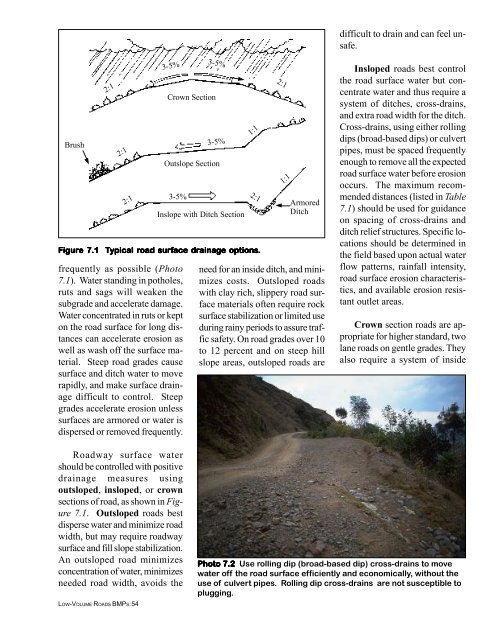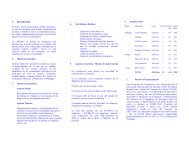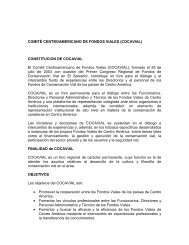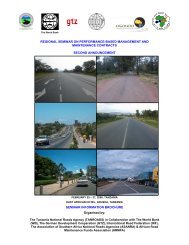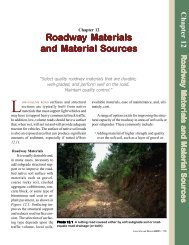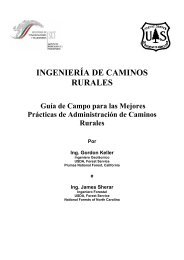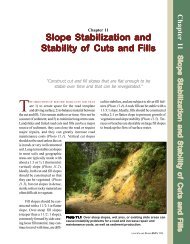Create successful ePaper yourself
Turn your PDF publications into a flip-book with our unique Google optimized e-Paper software.
difficult to drain and can feel unsafe.<br />
Brush<br />
2:1<br />
2:1<br />
2:1<br />
3-5%<br />
Figur<br />
igure e 7.1 Typical road surface draina<br />
ainage e options.<br />
frequently as possible (Photo<br />
7.1). Water standing in potholes,<br />
ruts and sags will weaken the<br />
subgrade and accelerate damage.<br />
Water concentrated in ruts or kept<br />
on the road surface for long distances<br />
can accelerate erosion as<br />
well as wash <strong>of</strong>f the surface material.<br />
Steep road grades cause<br />
surface and ditch water to move<br />
rapidly, and make surface drainage<br />
difficult to control. Steep<br />
grades accelerate erosion unless<br />
surfaces are armored or water is<br />
dispersed or removed frequently.<br />
Crown Section<br />
Outslope Section<br />
3-5%<br />
3-5%<br />
3-5%<br />
Inslope with Ditch Section<br />
1:1<br />
2:1<br />
2:1<br />
1:1<br />
Armored<br />
Ditch<br />
need for an inside ditch, and minimizes<br />
costs. Outsloped roads<br />
with clay rich, slippery road surface<br />
materials <strong>of</strong>ten require rock<br />
surface stabilization or limited use<br />
during rainy periods to assure traffic<br />
safety. On road grades over 10<br />
to 12 percent and on steep hill<br />
slope areas, outsloped roads are<br />
Insloped roads best control<br />
the road surface water but concentrate<br />
water and thus require a<br />
system <strong>of</strong> ditches, cross-drains,<br />
and extra road width for the ditch.<br />
Cross-drains, using either rolling<br />
dips (broad-based dips) or culvert<br />
pipes, must be spaced frequently<br />
enough to remove all the expected<br />
road surface water before erosion<br />
occurs. The maximum recommended<br />
distances (listed in Table<br />
7.1) should be used for guidance<br />
on spacing <strong>of</strong> cross-drains and<br />
ditch relief structures. Specific locations<br />
should be determined in<br />
the field based upon actual water<br />
flow patterns, rainfall intensity,<br />
road surface erosion characteristics,<br />
and available erosion resistant<br />
outlet areas.<br />
Crown section roads are appropriate<br />
for higher standard, two<br />
lane roads on gentle grades. They<br />
also require a system <strong>of</strong> inside<br />
Roadway surface water<br />
should be controlled with positive<br />
drainage measures using<br />
outsloped, insloped, or crown<br />
sections <strong>of</strong> road, as shown in Figure<br />
7.1. Outsloped roads best<br />
disperse water and minimize road<br />
width, but may require roadway<br />
surface and fill slope stabilization.<br />
An outsloped road minimizes<br />
concentration <strong>of</strong> water, minimizes<br />
needed road width, avoids the<br />
LOW-VOLUME ROADS BMPS:54<br />
Photo 7.2 Use rolling dip (broad-based dip) cross-drains to move<br />
water <strong>of</strong>f the road surface efficiently and economically, without the<br />
use <strong>of</strong> culvert pipes. Rolling dip cross-drains are not susceptible to<br />
plugging.


